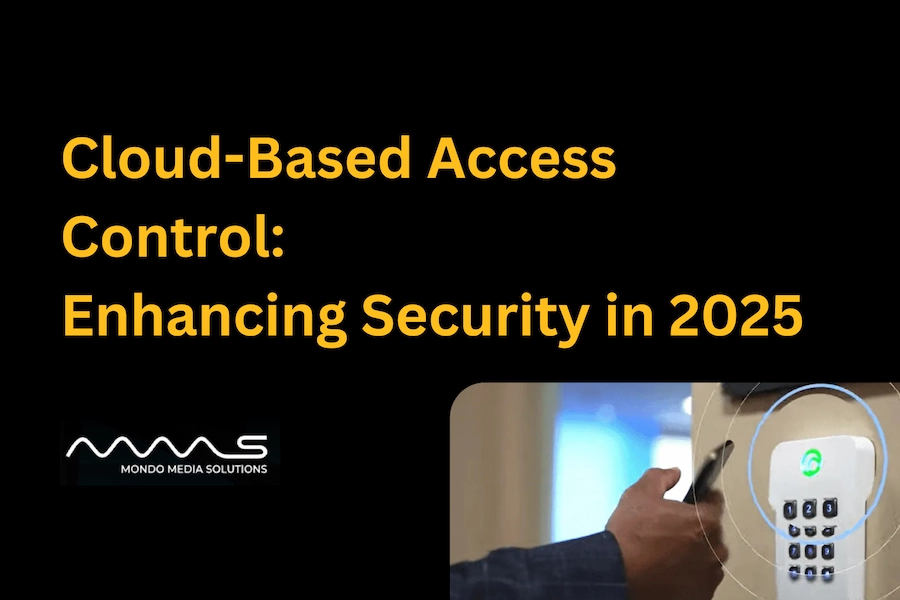In 2025, the landscape of security and access control is undergoing a significant transformation. Traditional on-premise systems are giving way to more agile, scalable, and intelligent solutions. At the forefront of this evolution are cloud-based access control systems, offering businesses enhanced security, flexibility, and efficiency.
As organizations seek to protect their assets and adapt to dynamic work environments, understanding the benefits and implementation of cloud-based access control becomes paramount.
What Is Cloud-Based Access Control?
Cloud-based access control systems are security solutions that manage and monitor access to physical locations through cloud-hosted platforms. Unlike traditional systems that rely on on-site servers, these solutions leverage the internet to provide real-time control and data storage.
Key Components:
- Remote Access Management: Administrators can control access permissions from any location using internet-connected devices.
- Cloud Storage: Access logs and system data are stored securely in the cloud, ensuring easy retrieval and analysis.
- Mobile Credentials: Users can gain entry using smartphones or wearable devices, reducing the need for physical keys or cards.
Why Cloud Is the Future of Access Control?
The shift towards cloud-based access control systems is driven by several compelling advantages:
- Scalability: Easily accommodate growing business needs without significant infrastructure changes.
- Flexibility: Manage multiple locations and user groups seamlessly from a centralized platform.
- Cost-Efficiency: Reduce expenses related to hardware, maintenance, and staffing by eliminating on-site servers.
- Real-Time Control: Implement immediate changes to access permissions, enhancing security responsiveness.
These benefits make cloud-based solutions an attractive option for businesses aiming to modernize their security infrastructure.
Key Trends Driving Adoption in 2025
Several trends are accelerating the adoption of cloud-based access control systems:
- AI-Powered Automation and Analytics: Integrating artificial intelligence enables predictive threat detection and automated responses, enhancing overall security.
- Touchless and Mobile Credential Access: The demand for hygienic and convenient access methods is leading to increased use of mobile and biometric credentials.
- Unified Security Platforms and IoT Integration: Combining access control with other security systems and IoT devices creates a cohesive and efficient security ecosystem.
These trends reflect a broader move towards smarter, more integrated security solutions.
Security Advantages of Cloud Access
Implementing cloud-based access control systems offers several security enhancements:
- End-to-End Encryption: Protects data during transmission and storage, safeguarding against unauthorized access.
- Role-Based Permissions: Ensures users have access only to areas necessary for their roles, minimizing security risks.
- Remote Lockdowns: Administrators can quickly secure facilities in emergencies, regardless of their physical location.
- Real-Time Alerts and Audit Trails: Immediate notifications of security events and comprehensive logs facilitate rapid response and compliance reporting.
These features contribute to a robust and proactive security posture for organizations.
Industry Use Cases
Cloud-based access control systems are versatile and applicable across various industries:
- Corporate Offices: Streamline employee access and monitor entry points across multiple locations.
- Healthcare Facilities: Secure sensitive areas and ensure compliance with health regulations.
- Educational Institutions: Manage student and staff access efficiently, enhancing campus safety.
- Multi-Site Enterprises: Centralize access control management for diverse and geographically dispersed operations.
These applications demonstrate the adaptability and benefits of cloud-based solutions in various settings.
Challenges and Considerations
While the advantages are significant, organizations should be mindful of potential challenges:
- Data Privacy: Ensuring compliance with regulations like GDPR requires careful data handling and storage practices.
- Internet Dependency: Reliable internet connectivity is essential for system functionality; contingency plans should be in place for outages.
- Integration with Existing Systems: Seamless integration with current infrastructure may require additional planning and resources.
Addressing these considerations is crucial for a successful transition to cloud-based access control.
Future Outlook
Looking ahead, cloud-based access control systems are poised to become even more sophisticated:
- AI and Predictive Analytics: Enhanced capabilities will allow for anticipatory security measures, identifying potential threats before they materialize.
- Interoperability Across Platforms: Greater standardization will facilitate integration with a broader range of devices and systems.
- User-Centric Design: Focus on intuitive interfaces and user experiences will improve system adoption and efficiency.
These developments will further solidify the role of cloud-based solutions in modern security strategies.
The evolution of cloud-based access control systems represents a significant advancement in security technology. By offering enhanced flexibility, scalability, and intelligence, these systems are well-suited to meet the complex demands of today’s organizations.
For businesses seeking to upgrade their security infrastructure, partnering with experienced providers is essential. Mondo Media Solutions specializes in access control installations, delivering tailored solutions that align with your specific needs. Embrace the future of security with confidence by leveraging their expertise in implementing cutting-edge, cloud-based access control systems.
